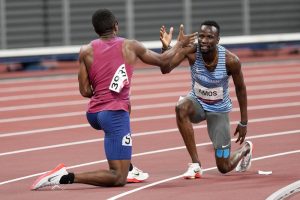3 Chapter 3
CHAPTER 3
“Beyond the Stereotype: Rethinking Black Athleticism in Media”?

Resisting Misogynoir
Rajack and Joseph highlight several strategies of resistance against misogynoir, such as reclaiming visibility and asserting Black women’s identities on their own terms. One strategy is the intentional self-representation of Black women athletes, like Serena Williams, who challenge the dominant narratives imposed on them. For example, Serena Williams’ unapologetic displays of emotion, despite being labeled as “angry” or “unruly,” push back against the stereotype that Black women should remain docile or restrained. By asserting her anger, she challenges the expectations of how Black women should behave in predominantly white spaces. Another strategy is the acknowledgment of multiple, complex racial identities, as seen in the case of Naomi Osaka, whose Haitian heritage is often erased in favor of her Japanese background. Advocating for recognition of mixed-race identities and refusing to let them be flattened into simplistic categories is a key aspect of resistance. Lastly, resisting misogynoir also involves rejecting the commodification of Black women’s bodies and narratives. This can be seen in the refusal to buy into the media’s portrayal of Black women as either hypersexualized or hyper-strong, and instead celebrating their full humanity and diversity of experiences.
Disrupting Narratives
The authors call for expanding the boundaries of what constitutes sports media, urging a shift away from mainstream outlets like ESPN. By including diverse media and journalists, they aim to challenge hegemonic gender representations and highlight underrepresented feminist perspectives, particularly those that critique systemic inequality.
“Game Changers: Sports, Activism, and the Power of Players”

In my opinion, the NBA’s approach to social justice and activism during the 2020 protests stands out for its strong alignment with the players and its public stances on racial justice. Unlike the NFL, which hesitated and struggled to coordinate a unified response, the NBA demonstrated a clear commitment to supporting the Black Lives Matter movement. The players, especially stars like LeBron James and others, were given a platform to lead and make their voices heard, resulting in impactful actions such as the boycotting of games and turning arenas into polling places.
This reflects a deep respect for the players’ influence and input, which contrasts with the NFL’s focus on protecting the bottom line and the reluctance to support Kaepernick’s peaceful protest. The NBA’s ability to balance activism with its business interests is something I admire because it shows that sports can be both a platform for change and a profitable enterprise. In contrast, the NFL’s delayed and cautious response to the same issues shows the tension that still exists in organizations that fear alienating their audiences, especially when the majority of players are Black. This comparison highlights how organizational structure, culture, and the relationship between owners and players can influence the way a sport reacts to societal issues.
I find this article insightful because it shows that the NBA’s success in handling this situation is rooted in a more collaborative and responsive approach to player power, and it demonstrates how social responsibility can be integrated into the business model without sacrificing profits.
Exploring Athlete Activism and Identity in Dear White People

In Dear White People, Joelle Brooks represents a racialized athlete activist who uses her platform as a track athlete to speak out about racial injustices, albeit in subtle and relational ways. Joelle’s activism is largely defined by her experiences navigating a predominantly white institution and the microaggressions she faces, which aligns with the forms of activism discussed in Cheryl Cooky and Dunja Antunovic’s article “This Isn’t Just About Us.” Joelle’s activism is not as public or as high-profile as male athletes like Colin Kaepernick, yet it speaks volumes about how women of color use sports as a stage to challenge racial and gendered systems of power.
Joelle’s form of resistance comes in moments like when she publicly confronts the expectations placed upon her as a Black woman in an elite, predominantly white space. She doesn’t necessarily stage dramatic protests like Kaepernick but uses her voice and body in ways that disrupt the status quo. This mirrors the activism of women athletes, like the WNBA players, who have been vocal about issues like police brutality and systemic racism but often don’t receive the same media attention as male athletes. Joelle, in many ways, is part of a broader tradition of activism by sportswomen that is frequently overlooked, as highlighted by Cooky and Antunovic, who point out that women’s activism often gets overshadowed by men’s in mainstream narratives.
In their article, Cooky and Antunovic explore how athlete activism, particularly that of women of color, is framed by the media and often marginalized. They argue that narratives of athlete activism typically center men or high-profile athletes, leaving the contributions of women, particularly women of color, on the periphery. Joelle’s activism, although not as visible as others’, challenges this by showing how personal acts of resistance can also be forms of powerful political speech, even when they don’t make national headlines.
Joelle’s activism also speaks to how sports themselves are understood as not just physical competition but arenas for broader societal issues. In Dear White People, sport becomes a tool for self-expression and resistance against larger systems of oppression, similar to the ways that athletes like the WNBA players and USWNT fight for racial and gender justice. These representations help to reshape our understanding of sports by presenting them as spaces where activism is not only possible but necessary.
Media Attributions
- 2.-US-and-Botswana
- sport-athletes-opinion
- AAAABeAb3-OprPVaEIcQRs-0F3niuwUcs6MVp114aRqIzgjlXDantCEfUFwh3ThiH0UfOd9F5lz_cqtkkFK8utNTitIte2TFvftJuXNq
